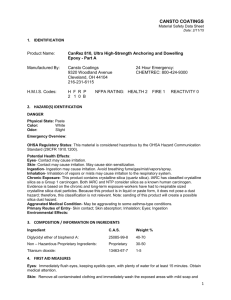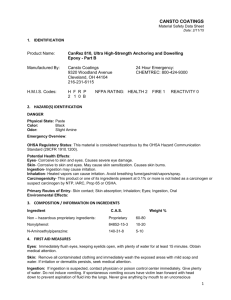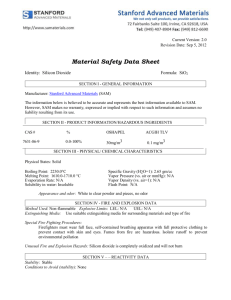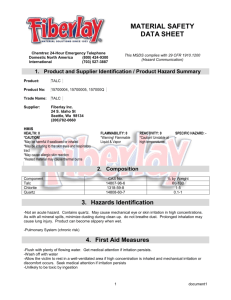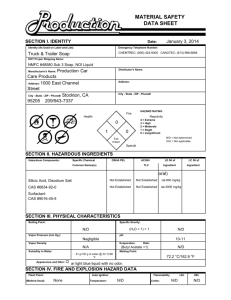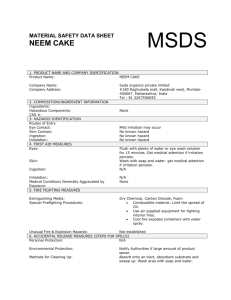CanRez 800, Ultra High-Strength Epoxy - Part B
advertisement
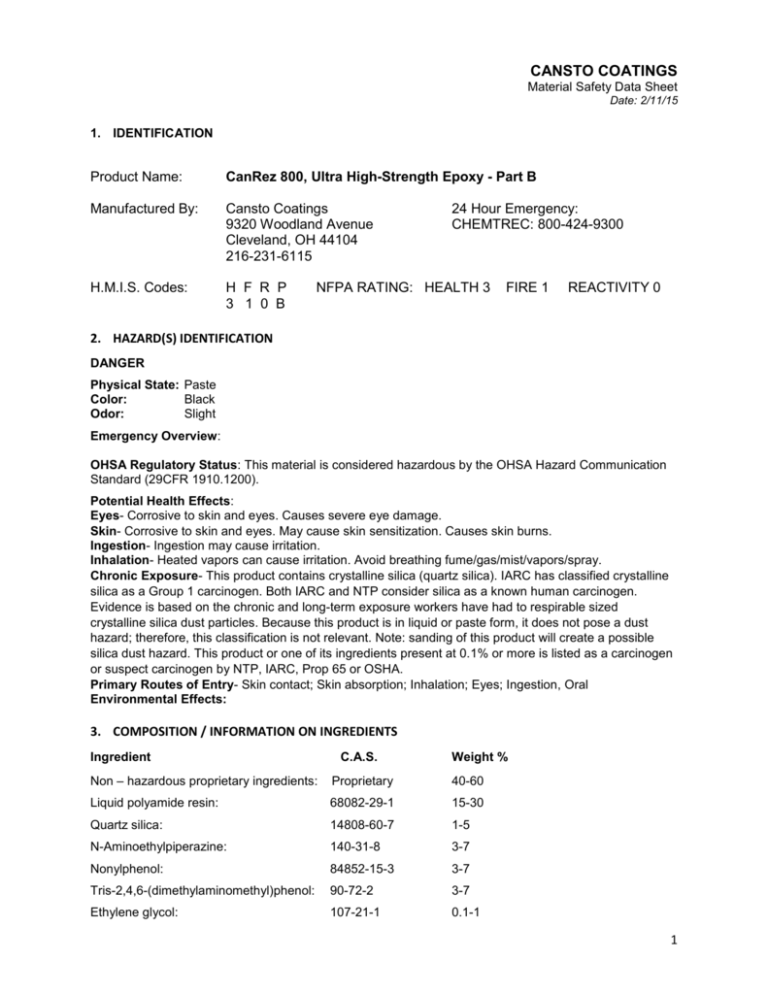
CANSTO COATINGS Material Safety Data Sheet Date: 2/11/15 1. IDENTIFICATION Product Name: CanRez 800, Ultra High-Strength Epoxy - Part B Manufactured By: Cansto Coatings 9320 Woodland Avenue Cleveland, OH 44104 216-231-6115 H.M.I.S. Codes: H F R P 3 1 0 B 24 Hour Emergency: CHEMTREC: 800-424-9300 NFPA RATING: HEALTH 3 FIRE 1 REACTIVITY 0 2. HAZARD(S) IDENTIFICATION DANGER Physical State: Paste Color: Black Odor: Slight Emergency Overview: OHSA Regulatory Status: This material is considered hazardous by the OHSA Hazard Communication Standard (29CFR 1910.1200). Potential Health Effects: Eyes- Corrosive to skin and eyes. Causes severe eye damage. Skin- Corrosive to skin and eyes. May cause skin sensitization. Causes skin burns. Ingestion- Ingestion may cause irritation. Inhalation- Heated vapors can cause irritation. Avoid breathing fume/gas/mist/vapors/spray. Chronic Exposure- This product contains crystalline silica (quartz silica). IARC has classified crystalline silica as a Group 1 carcinogen. Both IARC and NTP consider silica as a known human carcinogen. Evidence is based on the chronic and long-term exposure workers have had to respirable sized crystalline silica dust particles. Because this product is in liquid or paste form, it does not pose a dust hazard; therefore, this classification is not relevant. Note: sanding of this product will create a possible silica dust hazard. This product or one of its ingredients present at 0.1% or more is listed as a carcinogen or suspect carcinogen by NTP, IARC, Prop 65 or OSHA. Primary Routes of Entry- Skin contact; Skin absorption; Inhalation; Eyes; Ingestion, Oral Environmental Effects: 3. COMPOSITION / INFORMATION ON INGREDIENTS Ingredient C.A.S. Weight % Non – hazardous proprietary ingredients: Proprietary 40-60 Liquid polyamide resin: 68082-29-1 15-30 Quartz silica: 14808-60-7 1-5 N-Aminoethylpiperazine: 140-31-8 3-7 Nonylphenol: 84852-15-3 3-7 Tris-2,4,6-(dimethylaminomethyl)phenol: 90-72-2 3-7 Ethylene glycol: 107-21-1 0.1-1 1 4. FIRST AID MEASURES Eyes: Immediately flush eyes, keeping eyelids open, with plenty of water for at least 15 minutes. Obtain medical attention. Skin: Remove all contaminated clothing and immediately wash the exposed areas with mild soap and water. If irritation or dermatitis persists, seek medical attention. Ingestion: If ingestion is suspected, contact physician or poison control center immediately. Do not induce vomiting. If spontaneous vomiting occurs have victim lean forward with head down to prevent aspiration of fluid into the lungs. Never give anything by mouth to an unconscious person. Inhalation: Move to fresh air. If not breathing, give artificial respiration. If breathing is difficult, give oxygen and obtain medical attention. Acute: This material may cause irritation to skin and eyes. Product may cause an allergic skin reaction. Chronic: Prolonged or repeated skin contact may cause allergic skin reaction or dermatitis. Target organs: Acute: Eye, Skin, Oral Chronic: Skin Hazards: Pre-existing skin or eye problems may be aggravated by exposure to this product. In all cases, consult a physician for best treatment. 5. FIRE-FIGHTING MEASURES Extinguishing Media: Carbon dioxide, dry chemical, water fog. Unusual Fire and Explosion Hazard: None known. Thermal decomposition can be formed. Special Firefighting Procedures: Firefighter should be equipped with self-contained breathing Apparatus and full protective clothing to protect against potentially toxic and irritating fumes. Solvent vapors may be heavier than air and may build up and travel along the ground to an ignition source, which may result in a flash back to the source of the vapors. Cool fire-exposed containers with cold-water spray heat will cause pressure buildup and may cause explosive rupture. 6. ACCIDENTAL RELEASE MEASURES Leak or Spill: Ventilate. Eliminate all sources of ignition. Contain the spill. Avoid all personal contact. In enclosed areas, cleanup personnel should wear self-contained breathing apparatus. Spilled material and water rinses are classified as chemical waste, and must be disposed of in accordance with current local, provincial, and federal regulations. Evacuate all non-essential personnel. Prevent runoff into drains, sewers, and other waterways. Absorb with earth, sand, or another dry inert material. Cover spills with sawdust, vermiculite, or other absorbent material to minimize spreading of the material before collecting. Shovel into suitable unsealed containers, transport to well-ventilated area (outside) and treat with neutralizing solution: mixture of water (80%) with non-ionic surfactant Tergitol tmn-10 (20%), or; water (90%), concentrated ammonia (3-8%) and detergent (2%). 7. HANDLING AND STORAGE Handling Procedures: Avoid all eye and skin contact (including clothing). Avoid inhalation of vapors. Use with adequate ventilation. Wear an appropriate breathing apparatus. Handle and open container with care. Employees should wash hands and face before eating or drinking. Keep away from heat, sparks, and open flame. Storage: Keep away from heat, sparks, and open flames. Keep container closed when not in use. Store away from oxidizing and reducing materials. Store away from sunlight in cool dry place. Keep from freezing. Store between 40ºF and 95°F. Do not store near acids. Ground all transfer equipment. Good general housekeeping procedures should be followed. 8. EXPOSURE CONTROLS/ PERSONAL PROTECTION 2 Protective Equipment Eye: Chemical splash goggles, full face shield if there is a potential for splashing Respiratory: None normally required. Use a NIOSH/MSHA jointly approved respirator when air movement is inadequate to control vapor build-up. Gloves: Chemical resistant gloves Clothing/Footwear: Wear protective clothes and safety boots per local regulations Other Protective Equipment: Barrier cream, eye bath/wash stations, safety shower Ventilation: Provide natural or mechanical ventilation to control exposure levels below airborne exposure limits. Local mechanical exhaust ventilation should be used at sources or air contamination, such as open process equipment, or during purging operations, to capture gases and fumes that may be emitted. Standard reference sources regarding industrial ventilation should be consulted for guidance about adequate ventilation. In the event of thermal decomposition from overheating the product, evacuate the work area, shut down equipment, and provide general ventilation to the room prior to reoccupying. Ingredient TLV OHSA PEL Ethylene glycol: 100 mg/ m3 (ceiling) 50 ppm (ceiling) Quartz silica: 0.025 mg/m3 0.1 mg/m3 9. PHYSICAL / CHEMICAL DATA Form: Color: Odor: Vapor pressure: Vapor density (air=1): Evaporation rate: Solubility in water: Specific gravity (H20=1): pH: Boiling point: VOC content: Flash point: Paste Black Slight N/A Non-Volatile N/A Insoluble 1.05 Not Determined N/A 7.84 g/L (when mixed) 200ºF (93.34ºC) 10. STABILITY AND REACTIVITY Stability: Product is stable Conditions to Avoid: Exposure to excessive heat and storage above 95ºF will shorten shelf life. Incompatibility (Materials to Avoid): Strong acids, peroxides, and other oxidizing agents. Avoid extreme heat. Hazardous Decomposition Products: Can yield CO, CO2 and organic nitrogen compounds. Hazardous Polymerization: 11. TOXICOLOGICAL INFORMATION Effects of Overexposure Exposure: Skin: Corrosive to skin. May cause allergic skin reaction and irritation to the respiratory system. The product has not been tested. The statement has been derived from the properties of the individual components. Eyes: Sever damage to eyes. The product has not been tested. The statement has been derived from the properties of the individual components. Inhalation: Inhalation of vapors or mists may cause irritation to the respiratory system. Ingestion: May be harmful in ingested. 3 Maternal Toxicity: Nonylphenol causes maternal toxic effects per animal testing. Carcinogenicity: This product contains crystalline silica (quartz silica). IARC has classified crystalline silica as a Group 1 carcinogen. Both IARC and NTP consider silica as a known human carcinogen. Evidence is based on the chronic and long-term exposure workers have had to respirable sized crystalline silica dust particles. Because this product is in liquid or paste form, it does not pose a dust hazard; therefore, this classification is not relevant. Note: sanding of this product will create a possible silica dust hazard. This product or one of its ingredients present at 0.1% or more is listed as a carcinogen or suspect carcinogen by NTP, IARC, Prop 65 or OSHA. 12. ECOLOGICAL INFORMATION Environmental: Do not allow to enter waters, wastewater or soil. Biodegradability: No data Acute Toxicity for: Fish: Liquid polyamide resin: Zebrafish /LC50 (96hrs) : >5.0mg/l Aquatic Invertebrates: Liquid polyamide resin: Water Flea Daphnis/EC 50 (48hrs): > 7.07mg/l Algae: No Data Available Microorganisms: No Data Available Mobility: Considering the use of the substance, it is unlikely that significant environmental exposure in the air or water will arise. 13. DISPOSAL CONSIDERATIONS Waste Disposal Method: Dispose of in accordance with local, state and federal regulations. Empty containers must be handled with care due to product residue. This material and its container must be disposed of as hazardous waste. Avoid release to the environment. 14. TRANSPORT INFORMATION TDG Classification (ROAD): Cartridge: Limited Quantity, LTD QTY. Bulk: Corrosive Liquid, n.o.s. (Aminoethylpiperazine, 4-Nonylphenol, branched), Class 8, UN 1760, PG III IATA Classification (AIR): Cartridge and bulk: Corrosive Liquid, n.o.s. (Aminoethylpiperazine, 4Nonylphenol, branched), Class 8, UN 1760, PG III IMDG Classification (MARINE): Cartridge and bulk: Corrosive Liquid, n.o.s. (Aminoethylpiperazine, 4Nonylphenol, branched), Class 8, UN 1760, PG III 15. REGULATORY INFORMATION WHMIS Classification: OSHA: This product is considered hazardous under the federal OSHA hazard communication standard. CERCLA RQ: 5000 lbs. Chemical name: Ethylene glycol 107-21-1 SARA Tiles III / Section 302 – Extremely Hazardous: Chronic health hazard Section 311/312 – Hazard Categories: Chronic health hazard EPA Hazardous Air Pollutants (HAPS): TSCA Inventory Status: All components are listed. State RTK: NJ, MA, PA Chemical name: Ethylene Glycol 107-21-1 Quartz silica 14808-60-7 N-Aminoethylpiperazine 140-31-8 California Proposition 65: This product contains a chemical or chemicals known to the State of 4 California to cause cancer, birth defects or other reproductive harm. 16. OTHER INFORMATION Prepared Date: 2/11/15 Phone: 216-231-6115 IMPORTANT: The information and data herein are believed to be accurate and have been compiled from sources believed to be reliable. It is offered for your consideration, investigation and verification. Buyer assumes all risk of use, storage, and handling of the product in compliance with applicable federal, state and local laws and regulations. Cansto Coatings, makes no warranty of any kind, express or implied, concerning the accuracy or completeness of the information and data herein. Cansto Coatings, will not be liable for claims relating to any party’s use or reliance on information and data contained herein regardless of whether it is claimed that the information and data are inaccurate, incomplete or otherwise misleading. 5
